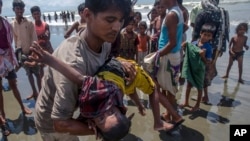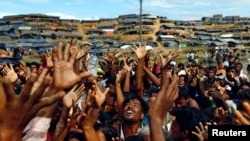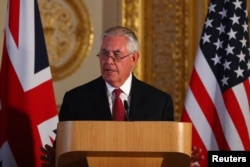As the number of Rohingya refugees fleeing violence in Myanmar to the relative safety of Cox's Bazar in southern Bangladesh reaches nearly 400,000, aid groups are escalating their response to an increasingly urgent humanitarian crisis.
But despite the push and donations from some governments, the sheer size of the problem leaves agencies unable to fully meet the growing demand, raising fears of serious consequences for the hungry and exhausted population, from disease outbreaks to deaths.
“If you go down there right now you will still see a lot of people facing open skies if I can put it that way,” said Azmat Ulla, Bangladesh country director for the International Federation of Red Cross and Red Crescent Societies (IFRC), who later added that the situation is "overwhelming."
The needs are varied, he added, from emergency shelter to health services to clean water purification to dignity kits, or essential items for women and girls who have been displaced. Most of the refugees going to Bangladesh are women and children.
Among its other duties, the IFRC has provided water to more than 20,000 people and is distributing water storage containers.
“There are also two mobile medical teams operating, each with a doctor, paramedic and two volunteers. For the first few days they’ve seen more than 500 people, and some of these people are suffering from diseases like diarrhea, fever, respiratory complaints, kidney infections, malnutrition as well as bullet wounds and burns,” he said. “There are also a number of people who are traumatized so we plan to add psychological support to the team.”
Rohingya Muslims have been fleeing what they say is long-term persecution in Myanmar for decades, but the speed combined with the scale of this latest crisis is unprecedented, experts say. Never before have so many arrived in so short a time.
Bangladesh already has hundreds of thousands Rohingya refugees in the country, adding to the burden.
This exodus started after insurgents from the Arakan Rohingya Salvation Army (ARSA) attacked police posts on August 25, killing at least 12 members of the security forces and sparking a brutal crackdown similar to one that occurred in October 2016 after a smaller assault on outposts that initially killed nine officers.
But while last year’s military operation resulted in allegations of possible crimes against humanity, the latest clashes appear to have been far more deadly, with Bangladesh’s government saying the death toll could be in the thousands and senior United Nations officials describing the outflow as ethnic cleansing.
Myanmar says it is killing terrorists and doing its best to rescue civilians and avoid collateral damage. It complains of media bias and misinformation, pointing to tens of thousands of Buddhists and other non-Muslims that have had to flee their own homes as an element of the story that has received little attention. Myanmar’s ambassador to the U.S. rejected has rejected allegations of ethnic cleansing.
U.S. Secretary of State Rex Tillerson has called for an end to the violence, and de facto Myanmar leader Aung San Suu Kyi cancelled a planned visit to the U.N. General Assembly, while planning to address the nation in the coming days on the crisis.
Meanwhile, Rohingya keep pouring into Bangladesh.
“The goal post is constantly changing because more people are arriving every day,” said Vivian Tan, spokeswoman for the United Nations refugee agency, UNHCR. “Every day you see new sites mushroom, sprouting up from the side of the road. So it’s quite difficult to keep track of the number of new arrivals and where they are going.”
Tan said the UNHCR had replenished its own stocks with two airlifts carrying family-size tents, plastic sheets and other essential items such as buckets and sleeping maps.
“We’re currently focusing on the two existing camps Kutupalong and Nayapara where the camp population has more than doubled in the last three weeks. And we’ve offered the government to scale up our assistance outside the camps,” she said.
The sense of urgency is made even greater by the fact that many arriving in Bangladesh have completed an arduous and taxing journey by sea, river and overland.
“The obvious risk is that people don’t get the assistance they need, and that we could see a second wave of health problems and even deaths. These people are already very weak having walked for days. I mean the latest I heard was 15 days. Imagine being on your feet for 15 days,” Tan said. “They often don’t have food, clean water is hard to come by so they are exhausted, they are weak, they are starving. So they need assistance in Bangladesh as soon as possible. If they don’t get it I shudder to think what could happen.”











